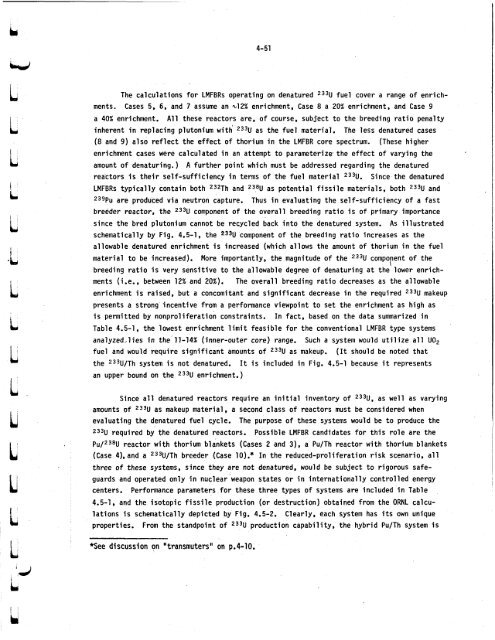ORNL-5388 - the Molten Salt Energy Technologies Web Site
ORNL-5388 - the Molten Salt Energy Technologies Web Site
ORNL-5388 - the Molten Salt Energy Technologies Web Site
Create successful ePaper yourself
Turn your PDF publications into a flip-book with our unique Google optimized e-Paper software.
ments.<br />
4-51<br />
The calculations for LMFBRs operating on denatured 233U fuel cover a range of enrich-<br />
Cases 5, 6, and 7 assume an %12% enrichment, Case 8 a 20% enrichment, and Case 9<br />
a 40% enrichment. All <strong>the</strong>se reactors are, of course, subject to <strong>the</strong> breeding ratio penalty<br />
inherent in replacing plutonium with 233U as <strong>the</strong> fuel material.<br />
(8 and 9) also reflect <strong>the</strong> effect of thorium in <strong>the</strong> LMFBR core spectrum. (These higher<br />
enrichment cases were calculated in an attempt to parameterize <strong>the</strong> effect of varying <strong>the</strong><br />
amount of denaturing.) A fur<strong>the</strong>r point which must be addressed regarding <strong>the</strong> denatured<br />
reactors is <strong>the</strong>ir self-sufficiency in terms of <strong>the</strong> fuel material 233U.<br />
LMFBRs typically contain both 232Th and 238U as potential fissile materials, both 233U and<br />
239Pu are produced via neutron capture. Thus in evaluating <strong>the</strong> self-sufficiency of a fast<br />
breeder reactor, <strong>the</strong> 233U component of <strong>the</strong> overall breeding ratio is of primary importance<br />
since <strong>the</strong> bred plutonium cannot be recycled back into <strong>the</strong> denatured system. As illustrated<br />
schematically by Fig. 4.5-1, <strong>the</strong> 233U component of <strong>the</strong> breeding ratio increases as <strong>the</strong><br />
allowable denatured enrichment is increased (which allows <strong>the</strong> amount of thorium in <strong>the</strong> fuel<br />
material to be increased). More importantly, <strong>the</strong> magnitude of <strong>the</strong> 233U component of <strong>the</strong><br />
\<br />
breeding ratio is very sensitive to <strong>the</strong> allowable degree of denaturing at <strong>the</strong> lower enrich-<br />
ments (i.e., between 12% and 20%).<br />
enrichment is raised, but a concomitant and significant decrease in <strong>the</strong> required 233U makeup<br />
presents a strong incentive from a performance viewpoint to set <strong>the</strong> enrichment as high as<br />
is permitted by nonproliferation constraints.<br />
Table 4.5-1, <strong>the</strong> lowest enrichment limit feasible for <strong>the</strong> conventional LMFBR type systems<br />
anaJyzed,lies in <strong>the</strong>'ll-14% (inner-outer core) range.<br />
fuel and would require significant amounts of 233U as makeup.<br />
<strong>the</strong> 233U/Th system is not denatured.<br />
an upper bound on <strong>the</strong> 233U enrichment.)<br />
The less denatured cases<br />
Since <strong>the</strong> denatured<br />
The overall breeding ratio decreases as <strong>the</strong> allowable<br />
In fact, based on <strong>the</strong> data summarized in<br />
Such a system would utilize all U02<br />
(It should be noted that<br />
It is included in Fig. 4.5-1 because it represents<br />
Since all denatured reactors require an initial inventory of 233U, as well as varying<br />
amounts of 233U as makeup material, a second class of reactors must be considered when<br />
evaluating <strong>the</strong> denatured fuel cycle. The purpose of <strong>the</strong>se systems would be to produce <strong>the</strong><br />
233U required by <strong>the</strong> denatured reactors. Possible LMFBR candidates for this role are <strong>the</strong><br />
Pu/~~*U reactor with thorium blankets (Cases 2 and 3), a Pu/Th reactor with thorium blankets<br />
(Case 41, and a 233U/Th breeder (Case lo).+ In <strong>the</strong> reduced-proliferation risk scenario, all<br />
three of <strong>the</strong>se systems, since <strong>the</strong>y are not denatured, would be subject to rigorous safe-<br />
guards and operated only in nuclear 'weapon states or in internationally controlled energy<br />
centers. Performance parameters for <strong>the</strong>se three types of systems are included in Table<br />
4.5-1, and <strong>the</strong> isotopic fissile production (or destruction) obtained from <strong>the</strong> <strong>ORNL</strong> calculations<br />
is schematically depicted by Fig. 4.5-2. Clearly, each system has its own unique<br />
properties. From <strong>the</strong> standpoint of 233U production capability, <strong>the</strong> hybrid Pu/Th system is<br />
*See discussion on "transmuters" on p.4-10.



![Review of Molten Salt Reactor Physics Calculations [Disc 2]](https://img.yumpu.com/21979492/1/190x247/review-of-molten-salt-reactor-physics-calculations-disc-2.jpg?quality=85)












